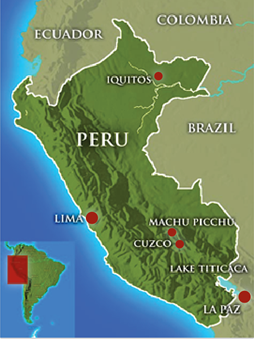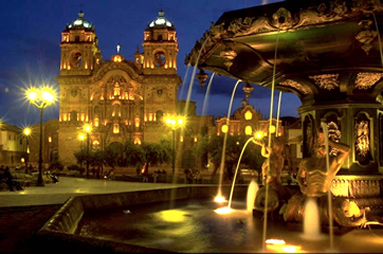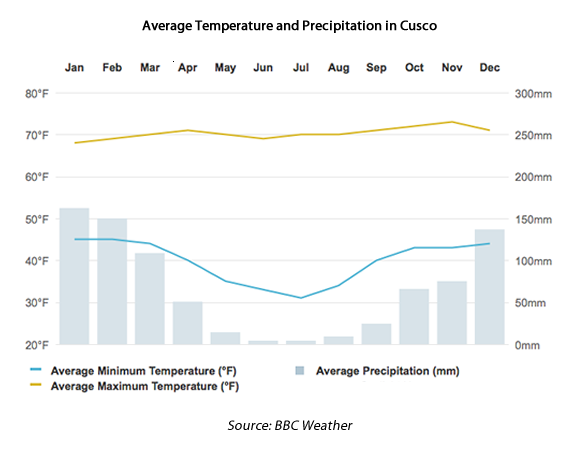








About Peru










Map of Peru
Once the seat of the illustrious Tawantinsuyo, the vast Inca Empire that extended from the lush jungle lowlands of modern-day Colombia to the scorching Atacama Desert in northern Chile, post-colonial Peru was forged at the juncture of the ruthless sword of the Spanish Conquest and the indefatigable will of its native inhabitants. Despite the European victory, the language, traditions and blood of the Inca peoples still flow freely through the veins of this Andean nation. Tragically, this clash of civilizations left a once mighty empire in ruins. Modern-day Peru, according to anthropological research, is far more destitute that its pre-Colombian counterpart. Many Peruvians struggle to meet their basic needs on a daily basis.
Poverty is most extreme in rural areas in the southern highlands of Peru. Nearly nine out of ten of the nation's rural poor live in the Andean Highlands, where they produce crops at the subsistence level.
Poverty in rural areas of Peru has its roots in:
Resources:

Cusco, often spelled Cuzco or Qosqo, is a city in southeastern Peru, near the Urubamba Valley of the Andes mountain range. It is the capital of the Cusco Region as well as the Cuzco Province. In 2012, the city has a population of approximately 400,00 which was triple the figure of 20 years ago. Located on the eastern end of the Knot of Cuzco, its elevation is around 3,400 m (11,200 ft).
Cusco was the site of the historic capital of the Inca Empire and was declared a World Heritage Site in 1983 by UNESCO. It is a major tourist destination and receives almost 2 million visitors a year. It is designated as the Historical Capital of Peru by the Constitution of Peru.
Cuzco was the capital of the Inca Empire (13th century-1532). Many believe that the city was planned as an effigy in the shape of a puma, a sacred animal. Under the Inca, the city had two sectors: the urin and hanan. Each was further divided to encompass two of the four provinces, Chinchasuyu (NW), Antisuyu (NE), Qontisuyu (SW) and Qullasuyu (SE). A road led from each of these quarters to the corresponding quarter of the empire. Each local leader was required to build a house in the city and live part of the year in Cuzco, but only in the quarter that corresponded to the quarter of the empire in which he had territory. After the rule of Pachacuti, when an Inca died, his title went to one son and his property was given to a corporation controlled by his other relatives (the process was called split inheritance). Each title holder had to build a new house and add new lands to the empire, in order to own the land his family needed to maintain after his death.
According to Inca legend, the city was built by Sapa Inca Pachacuti, the man who transformed the Kingdom of Cuzco from a sleepy city-state into the vast empire of Tahuantinsuyu. Archaeological evidence, however, points to a slower, more organic growth of the city beginning before Pachacuti. The city was constructed according to a definite plan, and two rivers were channeled around the city.
The city fell to the sphere of Huáscar in the division of the empire after the death of Huayna Capac in 1527. It was captured by the generals of Atahualpa in April 1532 in the Battle of Quipaipan. Nineteen months later, Spanish explorers invaded the city.
The first Spaniards arrived in the city on 15 November 1533. Francisco Pizarro officially arrived in Cuzco on 23 March 1534, renaming it the "Very noble and great city of Cuzco". The many buildings constructed after the Hispanic invasion have a mixture of Spanish influence with Inca indigenous tarchitecture, including the Santa Clara and San Blas neighborhoods. The Spanish destroyed many Inca buildings, temples and palaces. They used the remaining walls as bases for the construction of a new city.

The city was retaken from the Spanish during the Siege of Cuzco of 1536 by Manco Inca Yupanqui, a leader of the Sapa Inca. Although the siege lasted ten months, it was ultimately unsuccessful. Manco's forces were able to reclaim the city for only a few days. Throughout the conflict and years of the Spanish colonization of the Americas many of Inca citizens and warriors succumbed to smallpox and died.
Cuzco stands on layers of cultures, with the Tawantinsuyu (old Inca Empire) built on Killke structures, and the Spanish having replaced indigenous temples with Catholic churches, and palaces with mansions for the invaders.
Cuzco was the center for the Spanish colonization and spread of Christianity in the Andean world. It became very prosperous thanks to agriculture, cattle raising, and mining, as well as its trade with Spain. The Spanish colonists constructed many churches and convents, as well as a cathedral, university and Archbishopric. Just as the Inca built on top of Killke structures, Spanish buildings were based on the massive stone walls built by the Inca.
Source: Wikipedia
Resources:




































